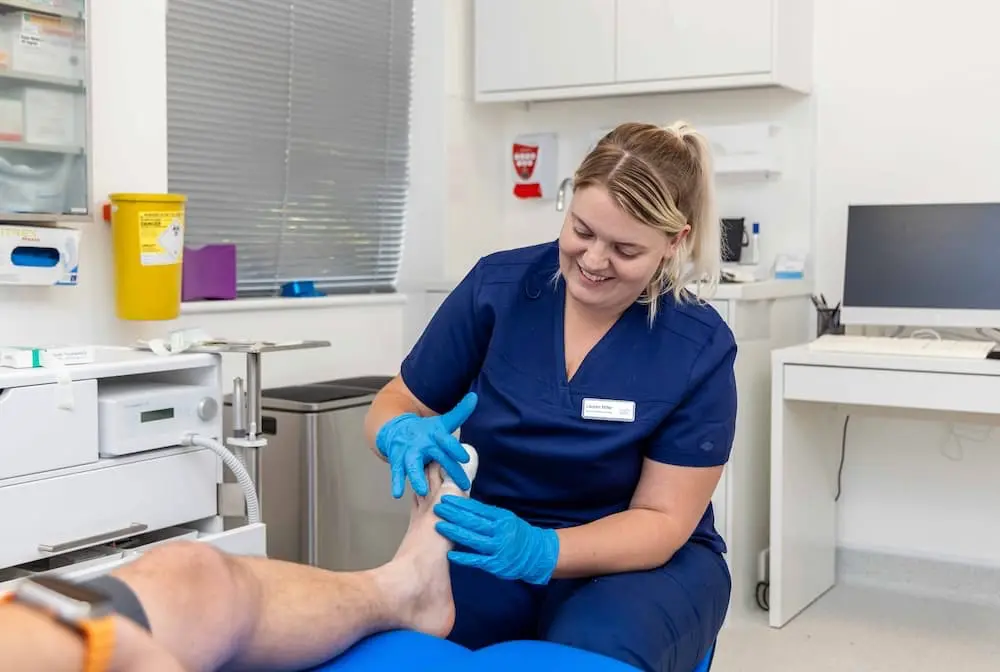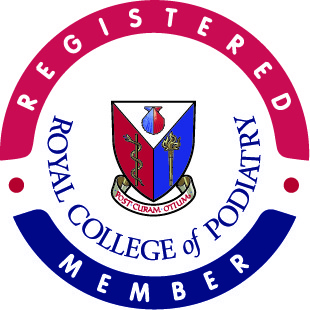ingrown toenail treatment
Have you got painful toes? Is the skin swollen, red or tender? Then you might have an ingrown toenail! Why suffer any longer? MyFootMedic offers fast permanent solutions for ingrown toenails.

Services
WHAT IS AN INGROWN TOENAIL?
An ingrown toenail is a common problem caused by the nail growing into the skin around it. The digging in effect caused by the nail can result in redness, pain and swelling.
If the skin becomes broken, bacteria can then enter the wound and cause an infection. You may experience fever-like symptoms, and you may notice a green or yellow pus-like fluid oozing out of the nail.
Any nail that curves downwards and into the skin can cause an infection, so inspect your toenails regularly and book an appointment with MyFootMedic if you’re in pain or you notice signs of infection.
WHAT CAUSES AN INGROWN TOENAIL?
INGROWN TOENAILS CAN BE CAUSED BY:
- Badly cut toenails that are too short
- Tight-fitting shoes, tights or socks that put pressure on the toes
- Injury to the nail like stubbing a toe or repeatedly kicking a ball
- Fungal infections
- Losing a nail through trauma
- Genetics
THERE ARE FOUR TYPES OF INGROWN TOENAIL:
- Involuted nail – strictly speak, this is not a true ingrown toenail. An involuted nail is where the nail is applying pressure on the surrounding skin but has not made a wound.
- Nail spike – this is where a section of the nail is either broken or has been cut poorly, and a point has formed. The ‘spike’ then pierces in to the skin leading to pain and potential infection.
- Onychocryptosis – this is where a large portion of nail has grown into the skin on either side of the nail. There will be red skin tissue to the side of the painful areas. An infection may also be present, and there is likely to be substantial pain when pressure is applied.
- Retronychia – this is a rarer form of ingrowing nail. The pain and redness is often at the base of the toenail. These are commonly accompanied by infection.
WHAT IS THE BEST INGROWN TOENAIL TREATMENT?
At MyFootMedic, we offer the most advanced treatments for ingrowing toenails that will deal with the problem in the most pain-free way. If you’re wondering what the cost of ingrown toenail surgery is, book an appointment at our Bedford clinic, and our footcare experts will talk through the following options with you.
PREVENTATIVE TREATMENT
Our extensive range of podiatry services are designed to spot problems early and prevent ingrown toenails from becoming an issue.
A foot health check will help our podiatrists to assess and diagnose signs of an ingrown toenail.
We’ll demonstrate the proper nail cutting techniques to help prevent ingrown toenails. Your foot care specialist will cut your nails correctly, and may remove a build-up of hard skin from the side of the nails to reduce the risk of any future problems.
Your podiatrist will develop a personalised foot care plan, including advice on foot hygiene and wearing correctly sized shoes, socks and tights.
MILD CASES OF INGROWN TOENAIL
Reshaping of the nails:
This technique will help to reshape the part of the nail that becomes ingrown, preventing the need for further intervention.
Nail resection:
During this procedure, a small piece of the edge of the nail is removed. This intervention is used to reduce pressure on the skin when an ingrown toenail is mild, and there's no problem with the base of the nail. A nail resection can be performed with or without a local anaesthetic.
Foot and nail care:
Your podiatrist will run you through a simple foot and nail care routine that can help to prevent a recurrence of the ingrown toenail. Your personalised plan includes nail cutting techniques and general advice on looking after your feet and toenails.
What if my ingrown toenail keeps coming back?
Ingrown toenails can become a recurrent problem that reduces your quality of life. If that’s the case, we offer a complete treatment plan that deals with infection and stubborn ingrown nails and can offer antibiotics to help fight infections.
Toenail surgery may be necessary if the nail is badly infected or the nail plate is too wide and causes recurring problems. There are two main options for toenail surgery:
A Partial Nail Avulsion is where the offending section of the nail is removed.
A Total Nail Avulsion is where the entire nail is removed, this is only recommended for severe cases.
With both options, the nail producing cells (nail matrix) will be treated to prevent the regrowth of unwanted sections of removed nail. Toenail surgery offers a permanent solution for ingrown toenails.
You may also be given prescription medicines for infection. Your Podiatrist will want to ensure that the infection is clearing, and the toe is healing properly.
This treatment has a fast recovery time and an extremely high success rate, allowing you to start living your life free of the pain of ingrown toenails.
LET'S ANSWER YOUR INGROWN TOENAIL QUESTIONS!
To fix an ingrown toenail, depends on the severity. For mild cases, we may recommend soaking the foot in warm water with salt. Wear proper footwear and trim nails straight across. If infection occurs, antibiotics may be required. Seek treatment from a podiatrist, especially for those with diabetes or poor blood flow. In severe cases, a minor surgical procedure may be considered.
If you have tried soaking your foot in warm water with salt and this hasn’t improved within a week, the fastest way to get rid of an ingrown toenail is to seek help from a podiatrist. Podiatrists are experts in nail problems and will be able to resolve the issue quickly. If you have diabetes or poor blood circulation, seek help from a podiatrist immediately.
No, an ingrown toenail does not typically go away by itself. Although some people may be able to manage it at home, treatment is usually required to alleviate the symptoms and prevent complications. Ingrown toenails occur when the nail grows into the skin next to the nail and can cause redness, tenderness, swelling, and pain. If left untreated, it can lead to infection.
If left untreated, an ingrown toenail can lead to various complications. The infection can spread to the bone beneath the nail, causing serious issues. Symptoms such as pain, redness, swelling, and discomfort while walking can worsen over time. In severe cases, the infection may even lead to gangrene. People with diabetes are particularly susceptible to complications and should seek immediate medical attention if they have an ingrown toenail. Prompt treatment is crucial to prevent the infection from spreading and causing further damage
Ingrown toenail treatment can vary in terms of pain depending on the severity of the condition and the chosen treatment method. Conservative approaches, such as soaking the foot in warm water and teaching proper nail-trimming technique, are generally not painful. Surgical options, on the other hand, may involve some discomfort during and after the procedure, but they are usually performed under local anaesthesia to make it as comfortable as possible. The original pain from in the ingrown toenail usually resolves instantly or shortly after treatment.
If you have an ingrown toenail, there are certain signs that indicate whether it is serious or not. Some symptoms of a serious ingrown toenail include pain, redness, swelling, and pus coming from the affected toe. If there is pain or signs of infection, such as pus or increasing redness, it is important to seek professional attention from a podiatrist.
Additionally, individuals with pre-existing health conditions like diabetes, severe nerve damage, poor blood circulation, or a nail infection should also consult a podiatrist for proper treatment. It is always better to err on the side of caution and seek professional advice if you are unsure about the seriousness of your ingrown toenail.
OVERCOME INGROWN TOENAIL PAIN AND RECLAIM YOUR FEET'S JOYFUL STEPS
Are you suffering from the discomfort and pain of ingrown toenails? Look no further than MyFootMedic for expert help and relief. We specialise in providing effective solutions to overcome ingrown toenail pain, allowing you to reclaim the joy of every step you take.
Don’t let ingrown toenails hold you back – visit MyFootMedic and take the first step towards a pain-free and joyful feet!









